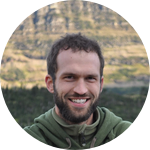About
My research broadly encompasses the study of landscapes and how they shape and are in turn shaped by flora and fauna populations. My expertise lies in leveraging satellite and aerial remote sensing measurements to take local processes and scale them up to landscape-level understanding. I apply creative problem solving to conservation and management questions arising from the influence of humans on wildlife population dynamics. My focus includes a special emphasis assessing long-term trends in vegetation productivity and phenological change as a result of a changing climate and the effect they have on wildlife populations.
I have a diverse field data collection background in several biomes with a variety of sensitive species and spend all of my free time outdoors in the Greater Glacier Ecosystem, Montana with family, allowing for insights and connections rare in the realm of “big data” scientists. My introduction to scaling-up on-the-ground ideas to the global scale began with my Master’s research, which took a field site idea and used it to develop a novel method to track extreme vegetation responses to drought using MODIS imagery.
Most recently I have developed new and creative methodologies using Google Earth Engine and R to map New England Cottontail habitat across Connecticut and to track changes in migratory patterns of elk (Cervus canadensis), tracked a grizzly bear (Ursus arctos) population expansion across formerly occupied range via genetic techniques, mapped an important grizzly food source throughout Glacier National Park using seasonal color change detected from NAIP and Landsat imagery, assessed and quantified phenological and productivity-related trends across the American West using remote-sensing measurements, and jumpstarted a project to count bison (Bison bison) from space with Blackfeet Nation interns.
Joined
November 2020

